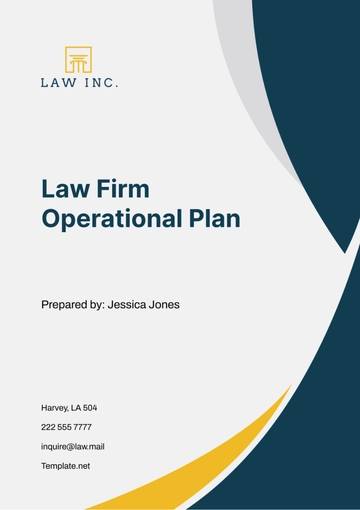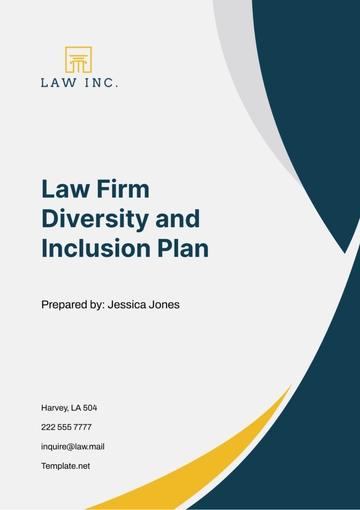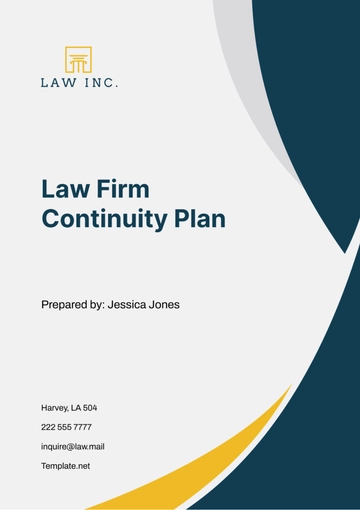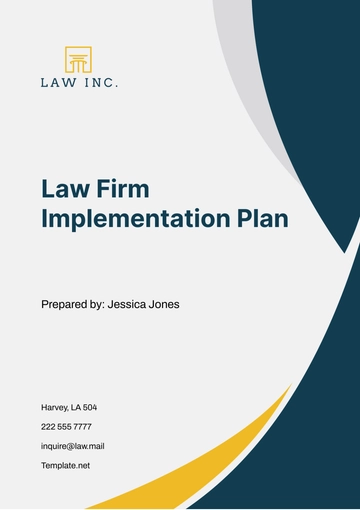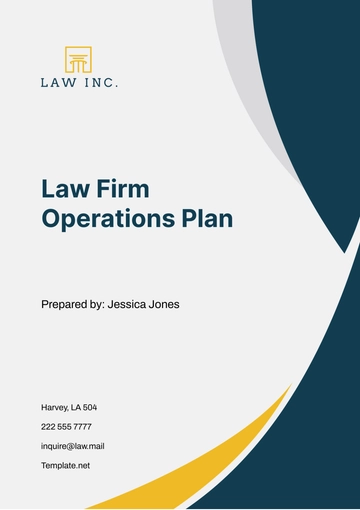Free Law Firm Media Plan

I. Executive Summary
Overview
The law firm's media plan aims to strategically position the firm in the competitive legal landscape, leveraging a combination of traditional and digital media channels to maximize brand visibility and client engagement. By focusing on key objectives such as increasing brand awareness, showcasing expertise, and driving client conversions, the plan sets a clear path for achieving measurable results. Through targeted messaging and tactical implementation, the firm seeks to establish itself as a trusted authority in its practice areas while fostering meaningful connections with its target audience.
Key Objectives
Objective | Description |
|---|---|
Increase brand awareness | Through strategic media placement and messaging, the firm aims to enhance recognition and recall among target clients and industry stakeholders. |
Showcase expertise | By highlighting the firm's specialized knowledge and successful case outcomes, the plan seeks to establish credibility and trust within the legal community. |
Drive qualified leads | Through targeted marketing campaigns and lead generation tactics, the firm aims to attract and convert potential clients seeking legal services. |
Strengthen client relationships | By prioritizing ongoing engagement efforts and personalized communication, the firm aims to foster loyalty and satisfaction among existing clients. |
II. Situation Analysis
Market Position
The firm enjoys several strengths, including a solid reputation, specialized expertise in niche practice areas, and a history of delivering favorable outcomes for clients. However, challenges such as limited brand visibility in certain markets and intense competition from larger firms pose notable hurdles. Despite these challenges, opportunities exist in emerging industries and geographic regions, where the firm can capitalize on its expertise and differentiate itself from competitors.
Strengths | Weaknesses | Opportunities | Threats |
|---|---|---|---|
Established reputation | Limited brand visibility in certain markets | Growing demand for legal services in emerging industries | Intense competition from larger firms |
Specialized expertise in key practice areas | Intense competition from larger firms | Expansion into new geographic regions | Regulatory changes impacting the legal industry |
Track record of successful client outcomes | Reliance on traditional marketing methods | Adoption of digital marketing strategies | Economic uncertainty |
Competitive Landscape
A detailed analysis of key competitors reveals their respective strengths, weaknesses, and market positioning strategies. By understanding competitor tactics and market dynamics, the firm can identify areas for differentiation and capitalize on untapped opportunities to gain a competitive edge.
Competitor | Strengths | Weaknesses | Market Positioning Strategy |
|---|---|---|---|
[Competitor A] | Strong brand recognition | Limited expertise in niche practice areas | Positioned as a full-service firm with a focus on corporate law and M&A |
Extensive network of industry connections | High turnover rate of junior associates | ||
[Competitor B] | Specialized expertise in complex litigation | Lack of diversity in leadership | Positioned as a boutique firm specializing in high-stakes litigation |
Established client base in specific industries | Limited geographic reach | ||
[Competitor C] | Innovative use of technology | Limited brand recognition in certain markets | Positioned as a disruptor in the legal tech space with a focus on delivering tech-driven solutions |
Strong track record of client satisfaction | High partner turnover |
Industry Trends
The legal industry is experiencing significant shifts driven by technological advancements, regulatory changes, and evolving client expectations. To stay ahead of the curve, the firm must stay abreast of emerging trends and adapt its strategies to align with shifting market dynamics. Opportunities abound in emerging practice areas and niche markets, where the firm can position itself as a leader and pioneer innovative solutions to meet evolving client needs.
Trend | Impact | Opportunity |
|---|---|---|
Technological Advancements | Streamlined processes and improved efficiency | Integration of legal tech solutions to enhance client service delivery |
Regulatory Changes | Increased compliance requirements | Expansion of practice areas to address emerging regulatory needs |
Evolving Client Expectations | Demand for personalized service and transparency | Implementation of client-centric approaches to service delivery |
III. Target Audience
Primary Audience
The firm's primary target audience comprises individuals and businesses in need of legal services within specific industries or practice areas. By understanding their demographics, psychographics, and behavior patterns, the firm can tailor its messaging and outreach efforts to resonate with their unique needs and preferences.
Secondary Audience
In addition to direct clients, the firm's secondary audience includes potential referral sources, such as other legal professionals, industry partners, and satisfied clients. These stakeholders play a crucial role in influencing client decisions and can serve as valuable advocates for the firm's services.
IV. Messaging and Positioning
Key Messages
The firm's key messages emphasize its commitment to client satisfaction, legal expertise, and personalized service. By conveying these messages consistently across all communication channels, the firm can reinforce its brand identity and build trust with its target audience.
Brand Positioning
The firm's brand positioning emphasizes its unique value proposition, including its depth of experience, track record of success, and client-centric approach. By clearly defining its brand identity and positioning, the firm can differentiate itself from competitors and establish a strong foothold in the market.
V. Media Channels and Tactics
Traditional Media
The firm will leverage traditional media channels such as print publications, television, radio, and outdoor advertising to reach a broad audience and reinforce brand messaging. Strategic placement in industry-specific publications and participation in relevant events will help the firm connect with target clients and industry influencers.
Digital Media
Digital media channels, including the firm's website, social media platforms, email marketing, and search engine marketing (SEM), offer opportunities to engage with target clients in real-time and track campaign performance. By implementing targeted advertising campaigns and leveraging data analytics, the firm can optimize its digital presence and drive qualified leads to its website.
Content Marketing
Content marketing initiatives, such as blog posts, articles, case studies, and whitepapers, will showcase the firm's expertise and provide valuable insights to its target audience. By creating high-quality, informative content tailored to the needs and interests of its audience, the firm can establish thought leadership and attract organic traffic to its website.
VI. Content Strategy
Content Calendar
The firm will develop a comprehensive content calendar outlining topics, formats, and distribution channels for content creation. This calendar will ensure a consistent flow of relevant and engaging content across all media channels, aligning with the firm's key messaging and target audience interests. By planning content in advance, the firm can maintain a steady cadence of communication and maximize the impact of its content marketing efforts.
Content Pillars
Content pillars will be identified based on the firm's core practice areas, industry trends, and client needs. These pillars will serve as the foundation for content creation, guiding the development of content themes and messaging that resonate with the target audience. By focusing on key areas of expertise, the firm can position itself as a trusted authority in its field and address the specific challenges and pain points faced by its clients.
VII. Budget and Resource Allocation
Budget Breakdown
The firm will allocate budget resources to traditional and digital media channels, content creation, advertising spend, and agency fees based on their respective effectiveness and ROI potential. A detailed budget breakdown will ensure that resources are allocated strategically to maximize impact and drive results across all aspects of the media plan. Regular monitoring and optimization of budget allocations will enable the firm to adapt to changing market conditions and emerging opportunities.
Resource Allocation
Internal team members and external partners will be assigned specific responsibilities and tasks to ensure the successful execution of the media plan. Clear lines of communication and collaboration will be established to facilitate seamless coordination and alignment of efforts across different departments and stakeholders. By leveraging the expertise and capabilities of internal and external resources, the firm can optimize resource allocation and achieve its marketing objectives efficiently.
VIII. Timeline and Implementation Schedule
Timeline
A detailed timeline and implementation schedule will be developed to guide the execution of the media plan, including specific milestones, deadlines, and key deliverables. By establishing a clear timeline, the firm can ensure that all activities are completed on schedule and that resources are allocated effectively to meet project deadlines. Regular progress updates and checkpoints will be scheduled to monitor progress and address any issues or delays proactively.
Implementation Schedule
Tasks and responsibilities will be assigned to internal team members and external partners based on their respective areas of expertise and availability. A centralized project management system will be utilized to track progress, communicate updates, and manage workflow efficiently. By adhering to the implementation schedule, the firm can maintain momentum and drive towards the successful execution of the media plan.
IX. Measurement and Evaluation
Key Performance Indicators (KPIs)
Key performance indicators (KPIs) will be defined to measure the success of the media plan, including website traffic, lead generation, client conversions, and brand sentiment. These KPIs will provide actionable insights into the effectiveness of marketing initiatives and help the firm assess its progress towards achieving its objectives. Regular monitoring and analysis of performance data will enable the firm to identify areas for improvement and optimize its marketing strategies accordingly.
KPI | Description |
|---|---|
Website Traffic | Number of visitors to the firm's website |
Lead Generation | Number of leads generated through marketing campaigns |
Client Conversions | Number of clients acquired through marketing efforts |
Brand Sentiment | Sentiment analysis of online mentions and reviews |
Performance Analysis
Performance data will be regularly reviewed and analyzed to evaluate the impact of marketing initiatives and identify areas for optimization. Insights gathered from performance analysis will inform strategic decision-making and enable the firm to refine its messaging, targeting, and tactics to better resonate with its target audience. By continuously monitoring performance metrics and adjusting strategies as needed, the firm can maximize the ROI of its media plan and drive long-term success.
Metric | Measurement Method | Analysis Approach |
|---|---|---|
Website Traffic | Google Analytics | Identify trends in website traffic, including sources and referral paths |
Lead Generation | CRM system | Track lead sources, conversion rates, and quality of leads |
Client Conversions | CRM system | Monitor client acquisition metrics, including conversion rates and retention |
Brand Sentiment | Social media monitoring tools | Analyze sentiment scores and feedback from online reviews and mentions |
X. Conclusion
Key Takeaways
In conclusion, the law firm's media plan provides a comprehensive roadmap for achieving its marketing objectives and driving business growth. By leveraging a mix of traditional and digital media channels, implementing targeted messaging and tactics, and continuously monitoring performance, the firm can position itself for success in a competitive market landscape. With a clear focus on delivering value to its target audience and fostering meaningful relationships, the firm is poised to achieve its goals and elevate its brand to new heights.
- 100% Customizable, free editor
- Access 1 Million+ Templates, photo’s & graphics
- Download or share as a template
- Click and replace photos, graphics, text, backgrounds
- Resize, crop, AI write & more
- Access advanced editor
Manage your law firm's media strategy effortlessly with the Law Firm Media Plan Template from Template.net. This editable and customizable template features an intuitive AI Editor Tool, allowing you to tailor your plan to perfection. Elevate your brand's visibility and attract clients effectively with this comprehensive resource. Simplify your marketing efforts and achieve success with ease.
You may also like
- Finance Plan
- Construction Plan
- Sales Plan
- Development Plan
- Career Plan
- Budget Plan
- HR Plan
- Education Plan
- Transition Plan
- Work Plan
- Training Plan
- Communication Plan
- Operation Plan
- Health And Safety Plan
- Strategy Plan
- Professional Development Plan
- Advertising Plan
- Risk Management Plan
- Restaurant Plan
- School Plan
- Nursing Home Patient Care Plan
- Nursing Care Plan
- Plan Event
- Startup Plan
- Social Media Plan
- Staffing Plan
- Annual Plan
- Content Plan
- Payment Plan
- Implementation Plan
- Hotel Plan
- Workout Plan
- Accounting Plan
- Campaign Plan
- Essay Plan
- 30 60 90 Day Plan
- Research Plan
- Recruitment Plan
- 90 Day Plan
- Quarterly Plan
- Emergency Plan
- 5 Year Plan
- Gym Plan
- Personal Plan
- IT and Software Plan
- Treatment Plan
- Real Estate Plan
- Law Firm Plan
- Healthcare Plan
- Improvement Plan
- Media Plan
- 5 Year Business Plan
- Learning Plan
- Marketing Campaign Plan
- Travel Agency Plan
- Cleaning Services Plan
- Interior Design Plan
- Performance Plan
- PR Plan
- Birth Plan
- Life Plan
- SEO Plan
- Disaster Recovery Plan
- Continuity Plan
- Launch Plan
- Legal Plan
- Behavior Plan
- Performance Improvement Plan
- Salon Plan
- Security Plan
- Security Management Plan
- Employee Development Plan
- Quality Plan
- Service Improvement Plan
- Growth Plan
- Incident Response Plan
- Basketball Plan
- Emergency Action Plan
- Product Launch Plan
- Spa Plan
- Employee Training Plan
- Data Analysis Plan
- Employee Action Plan
- Territory Plan
- Audit Plan
- Classroom Plan
- Activity Plan
- Parenting Plan
- Care Plan
- Project Execution Plan
- Exercise Plan
- Internship Plan
- Software Development Plan
- Continuous Improvement Plan
- Leave Plan
- 90 Day Sales Plan
- Advertising Agency Plan
- Employee Transition Plan
- Smart Action Plan
- Workplace Safety Plan
- Behavior Change Plan
- Contingency Plan
- Continuity of Operations Plan
- Health Plan
- Quality Control Plan
- Self Plan
- Sports Development Plan
- Change Management Plan
- Ecommerce Plan
- Personal Financial Plan
- Process Improvement Plan
- 30-60-90 Day Sales Plan
- Crisis Management Plan
- Engagement Plan
- Execution Plan
- Pandemic Plan
- Quality Assurance Plan
- Service Continuity Plan
- Agile Project Plan
- Fundraising Plan
- Job Transition Plan
- Asset Maintenance Plan
- Maintenance Plan
- Software Test Plan
- Staff Training and Development Plan
- 3 Year Plan
- Brand Activation Plan
- Release Plan
- Resource Plan
- Risk Mitigation Plan
- Teacher Plan
- 30 60 90 Day Plan for New Manager
- Food Safety Plan
- Food Truck Plan
- Hiring Plan
- Quality Management Plan
- Wellness Plan
- Behavior Intervention Plan
- Bonus Plan
- Investment Plan
- Maternity Leave Plan
- Pandemic Response Plan
- Succession Planning
- Coaching Plan
- Configuration Management Plan
- Remote Work Plan
- Self Care Plan
- Teaching Plan
- 100-Day Plan
- HACCP Plan
- Student Plan
- Sustainability Plan
- 30 60 90 Day Plan for Interview
- Access Plan
- Site Specific Safety Plan





